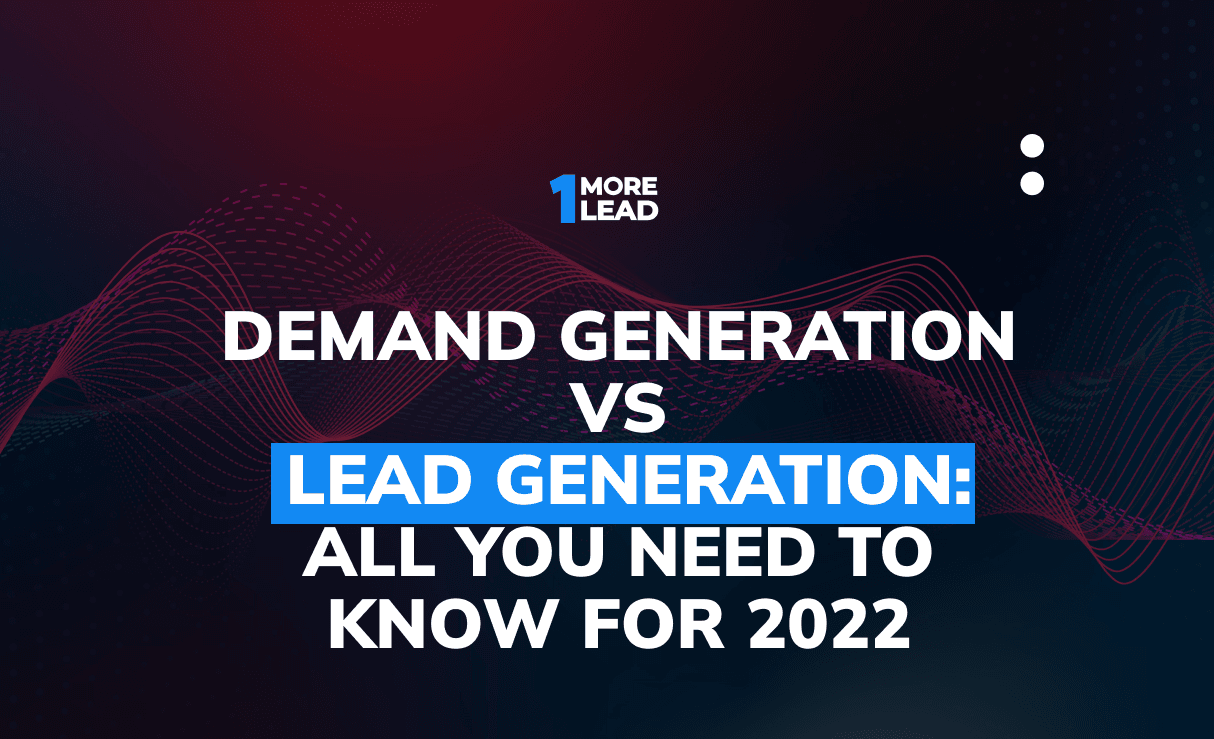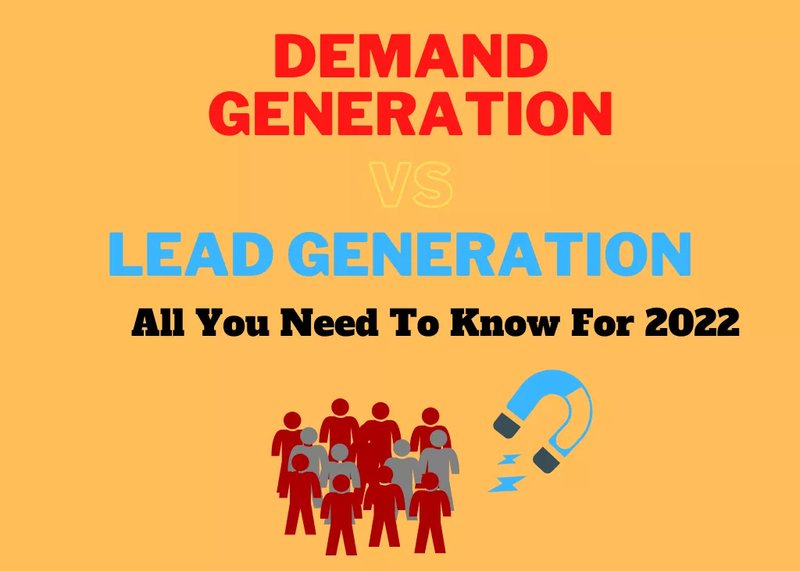
Nowadays, many digital marketers use the terms demand & lead generation as if they were one and the same – they are not. This has understandably led to some confusion surrounding these terminologies.

To clarify, lead generation is somewhat of a subsection of demand generation. You must put your demand gen plan in place before sustaining success with lead generation. Without first creating demand, you cannot produce decent leads.
In this article, we will discuss the following –
Demand generation is the practice of increasing interest and demand for the services/products your company offers — without the intention of having these contacts turn into leads in your CRM (that is more the domain of lead generation). Demand generation is to define your consumer base, develop brand loyalty, and achieve thought leadership. Your audience grows, the hype is created, and traffic increases, encouraging people to take action.
According to this definition, neither lead generation nor demand generation is actually subsets of each other. Instead, a prospective client might come into contact with your brand through your demand generation activities before becoming a lead through your lead-generating activities.
If you accepted the word "demand generation" (or "demand gen") at the surface level, you could assume that it solely refers to creating a generalized, immeasurable "demand" for your good or service. Demand generation is a shortened term for data-driven marketing techniques that raise curiosity and enthusiasm.
It's crucial to remember that demand creation doesn't just mean "raising brand awareness." Demand generation can undoubtedly result in more people learning about your business, but the true way to create demand is to educate your target market about their problems and how your service can solve them.
Demand creation is going after prospects where they are right now with customized content and offers instead of waiting for them to find you.
A buyer persona is a critical component of every one of your marketing initiatives. Your persona study will give you a deeper understanding of your key demographic's online habits, the sources they believe in, and their problems — which is especially helpful for demand generation.
Your objective in the demand generation funnel is to raise awareness in order to attract potential customers at the top of the funnel. You can saturate them with lead generation content once they're further down the funnel. In a nutshell, brand awareness fosters favorable linkages between potential customers' experiences and your good or service.
A schedule of guest posting throughout social media platforms can provide you more chances to reach out to prospective customers and show your competence in their topic of interest. This is a great approach for marketers trying to boost their search rankings and credibility simultaneously. Building relationships with high-authority websites and contributing material to them is a good way to increase organic traffic. It can also assist readers in the introductory stage of the buyer's journey get to be familiar with & trust your work better, eventually leading to them becoming leads and, eventually, customers.
You can boost your search ranks, drive more traffic, and establish authority with the best prospects who are just starting the buying process by including an efficient on-page and off-page SEO campaign in your demand generation initiatives. Maintaining top results for your most valuable keywords requires time and effort, but it can build credibility before a potential customer even arrives at your website. To retain excellent search rankings, everything in your content should be constructed around your primary keyword approach.
Since content is a major factor in guiding prospects through your sales funnel, it's critical to identify your current content and the ones you still need to produce. Content is useful in determining which existing content would be the best fit for your demand generation strategy.
Thought leadership is an incredible way for your brand to be associated with the values and ideals your target customers strive toward – it makes your brand seem more than a business, somewhat like a family your prospects want to be a part of. The foundation of this practice resides with the person representing your brand and their message to the world. Notable examples of thought leaders include individuals such as Dan Price, Elon Musk ( with some controversy), Steve Jobs, Bill Gates, and many more.
Lead generation is the process of converting potential consumers (or prospects) who express interest in your goods or services into paying clients.
The results of your demand generation marketing activities are leads. In other words, demand generation brought them to your sight; lead generation will get them to your wallet. When it comes to generating B2B leads, there are practically unlimited strategies a marketer can use to turn those curious prospects into clients. The overarching objective of your campaign will determine the material most effective for delivering your message.
Lead generation techniques are far more specialized and focused than demand generation's broad approach. They might include webinars or white papers that are part of gated content marketing with streamlined landing pages. They might also concentrate on longer-term drip email marketing to nurture leads.
Gated content is material that internet users (or potential clients) can only view or download after visiting your website and providing you with certain personal data. The sales staff will then normally receive these contact details to establish a relationship.
A great approach to gathering some crucial data on the individuals using your web assets is through gated content. This data frequently shapes email accounts, job titles, business names, and contact information. A "lead magnet" is another name for this kind of content marketing.
Users gain access to various resources in return for this extremely important information, including webinars, video lessons, polls and research, ebooks, newsletters, and many more. The most crucial thing to remember is that if prospects are providing you with sensitive information about themselves, they will anticipate something valuable and personalized in return.
It's crucial to examine strategies for lead generation that go beyond copywriting. In addition to being accessible, audio and video information like webinars and podcasts are also simple for potential customers to consume.
Sometimes, marketers might distribute an infographic you produced, while others would use their time commuting to work in the morning to listen to your podcast. While a buyer cannot download a lead magnet, they can view product videos or tutorials.
Utilizing retargeting allows you to capitalize on the curiosity a prospect has previously shown in your company by keeping your brand and/or product portfolio in their sights after they have visited your website and shown interest in it. Retargeting enables marketers to provide programmed touch-points and follow-up pitches to prospects who aren't yet ready to sign up to a product or service, cultivating them until the moment is ripe for a discussion, a trial, or a purchase. Retargeted ads are important and very effective since consumers who see them are more inclined to convert.
Another fantastic component of the lead generation spread that several B2B marketers frequently neglect is social media. While it's true that social media has typically been associated with B2C marketing, a growing number of B2B companies are now utilizing the influence of sites like Twitter & LinkedIn to inform their consumers about their special product portfolio and upgrades.
Social media strategy for businesses shouldn't be boring. When CMOs and other decision-makers are looking for answers, the more inventive you can be with your brand's online presence, the more you will distinguish yourself. Posts on social media can help you personalize your company. Prospects looking for answers to their inquiries and a direct source of communication with your official brand accounts may also do so.
White papers are incredibly technical texts that educate readers on a particular subject or problem they may be facing. Due to their frequent focus on decision-makers, white papers that can be downloaded make effective lead magnets.
White papers are frequently a gated resource in the lead generation context, similar to case studies, that can either emphasize a single issue or a problem along with its solution. The former is a wonderful resource to employ at the beginning of the shopping process. It encourages a prospect to take prompt corrective action by validating their concerns that something is amiss. Another wonderful downloadable resource for furthering the lead gen nurturing process is white papers that emphasize a problem and a solution.
White papers are not for brief interactions meant to capture leads, which is a crucial distinction to make. If it appears like the entire paper was designed to pressure readers into buying a service, they will abandon it right away. White papers that are effective balance being both informed and compelling. By using objective statistics, you may show readers that your company is dependable and prioritizes customers' needs before financial gain.
Demand & lead generation vary in a straightforward way. The goal of demand generation is to increase anticipation or demand for your product portfolio through marketing initiatives. The foundation of lead generation marketing is in initiatives to gather data about prospective clients and convert them into leads.
Demand generation aims to raise interest in your business's goods or services and encourage customers to purchase from you. Initiatives for demand generation collect leads based on particular inclinations and are typically created through lead generation landing pages for free services or for individuals who desire additional about your product line/service. This is frequently a long-term strategy that prioritizes brand recognition and positioning. As a result, you want to connect with as many individuals as possible.
The converse is true in terms of lead generation. You must gather data about prospective consumers if you want to produce more qualified leads. Then, you may cultivate your leads with pertinent content using customized marketing strategies. As mentioned previously -- gated content, whitepapers, webinars, social media presence, webinars, and content make up most of gated lead-generating content.
Although both lead generation and demand generation essentially have the same purpose, they must be carried out in the right order in order to produce optimal conversion and maintain a robust funnel. Your sales teams won't have the number of incoming leads required to produce sales metrics without a strong demand-gen plan.
Another crucial element in the sustainability of your pipeline is the variety of your demand generation. Prospects use a variety of avenues for browsing and working, and they each favor distinct methods of information gathering. The best method to ensure you're not passing up on valuable chances is to have a robust selection of promotional videos, social media postings, guest appearances, lecture events, and PPC marketing.
Additionally, compelling incentives and CTAs during the demand generation phase can encourage prospects to focus on a business, providing lead generation the best shot to persuade them to provide contact details and continue with the buying cycle.
Demand generation involves teaching people about the challenges that your business can address by producing free material that is occasionally commercial in nature. The goal is to draw in a large audience and raise your brand's visibility.
In contrast, lead generation concentrates on emphasizing your product's benefits and setting it apart from rivals. The objective is to draw in a particular demographic that is most likely to become paying clients. To achieve the best outcomes, marketing experts should concentrate on how lead generation and demand creation differ from one another.
Moreover, if your business requires a streamlined process for gathering leads, look no further than OneMoreLead. OneMoreLead has a database of over 55 million verified B2B prospects you may choose from to build your ideal list at a moment’s notice. OneMoreLead’s efficacy has enabled it to partner with renowned brands such as Shopify, Google, Microsoft, Zapier, and many more.